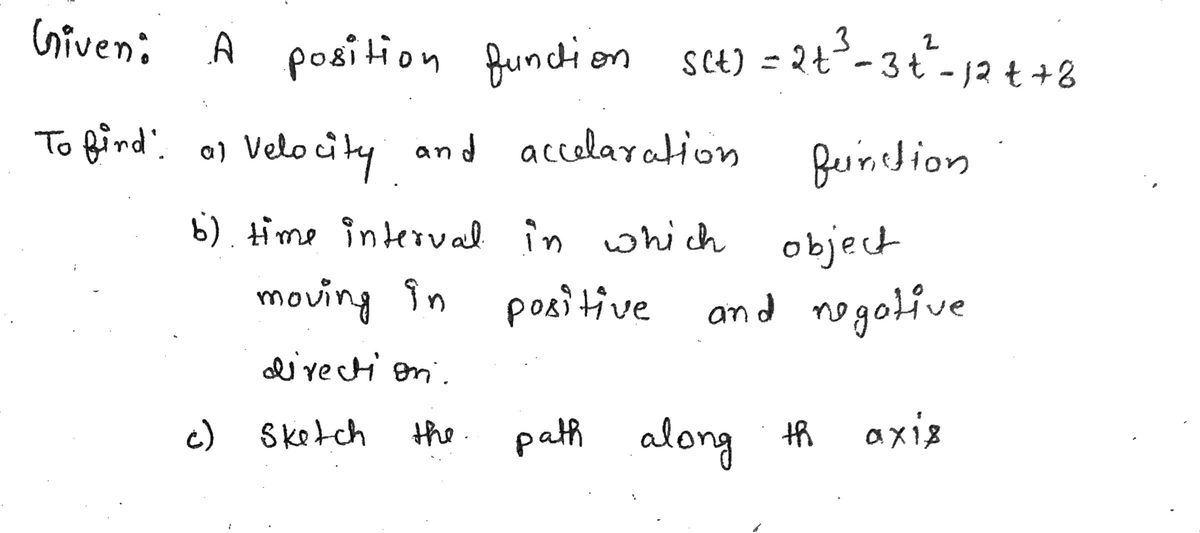2. The position function of an object is given by s(t) = 2t³ - 3t² - 12t + 8 where t 20. a) Find the velocity and acceleration functions. b) Find the time interval in which the object is moving in the positive direction. Find the time interval in which the object is moving in the negative direction. c) Sketch the path of the particle along a coordinate axis. d) Find the displacement and the distance traveled from t = 1 to t = 3. (Remember that distance refers to the actual ground that an object has covered during its motion. Displacement describes the overall change in position, or how far away and in which direction an object is from its original location.)
2. The position function of an object is given by s(t) = 2t³ - 3t² - 12t + 8 where t 20. a) Find the velocity and acceleration functions. b) Find the time interval in which the object is moving in the positive direction. Find the time interval in which the object is moving in the negative direction. c) Sketch the path of the particle along a coordinate axis. d) Find the displacement and the distance traveled from t = 1 to t = 3. (Remember that distance refers to the actual ground that an object has covered during its motion. Displacement describes the overall change in position, or how far away and in which direction an object is from its original location.)
Calculus: Early Transcendentals
8th Edition
ISBN:9781285741550
Author:James Stewart
Publisher:James Stewart
Chapter1: Functions And Models
Section: Chapter Questions
Problem 1RCC: (a) What is a function? What are its domain and range? (b) What is the graph of a function? (c) How...
Related questions
Question
Plshelp

Transcribed Image Text:←
Home
ņe
II
Insert
73°F
Sunny
AªI
Draw
View Help
2. The position function of an object is given by s(t) = 2t³ − 3t² − 12t + 8 where t ≥ 0.
a) Find the velocity and acceleration functions.
b) Find the time interval in which the object is moving in the positive direction. Find the time
interval in which the object is moving in the negative direction.
c) Sketch the path of the particle along a coordinate axis.
d) Find the displacement and the distance traveled from t = 1 to t = 3. (Remember that
distance refers to the actual ground that an object has covered during its motion. Displacement
describes the overall change in position, or how far away and in which direction an object is
from its original location.)
a.) v(+) = 5²(²)
b.)
a(t) = silt)
6+² - 6t-12
OneNote for Windows 10
lat-6
Shapes
Ink to Shape
a
Sa
N
Ink to Text
Ruler
simran cheema
Math
<
♫
Share
x :
11:42 AM
9/20/2022
Expert Solution
Step 1

Trending now
This is a popular solution!
Step by step
Solved in 3 steps with 3 images

Recommended textbooks for you

Calculus: Early Transcendentals
Calculus
ISBN:
9781285741550
Author:
James Stewart
Publisher:
Cengage Learning

Thomas' Calculus (14th Edition)
Calculus
ISBN:
9780134438986
Author:
Joel R. Hass, Christopher E. Heil, Maurice D. Weir
Publisher:
PEARSON

Calculus: Early Transcendentals (3rd Edition)
Calculus
ISBN:
9780134763644
Author:
William L. Briggs, Lyle Cochran, Bernard Gillett, Eric Schulz
Publisher:
PEARSON

Calculus: Early Transcendentals
Calculus
ISBN:
9781285741550
Author:
James Stewart
Publisher:
Cengage Learning

Thomas' Calculus (14th Edition)
Calculus
ISBN:
9780134438986
Author:
Joel R. Hass, Christopher E. Heil, Maurice D. Weir
Publisher:
PEARSON

Calculus: Early Transcendentals (3rd Edition)
Calculus
ISBN:
9780134763644
Author:
William L. Briggs, Lyle Cochran, Bernard Gillett, Eric Schulz
Publisher:
PEARSON

Calculus: Early Transcendentals
Calculus
ISBN:
9781319050740
Author:
Jon Rogawski, Colin Adams, Robert Franzosa
Publisher:
W. H. Freeman


Calculus: Early Transcendental Functions
Calculus
ISBN:
9781337552516
Author:
Ron Larson, Bruce H. Edwards
Publisher:
Cengage Learning